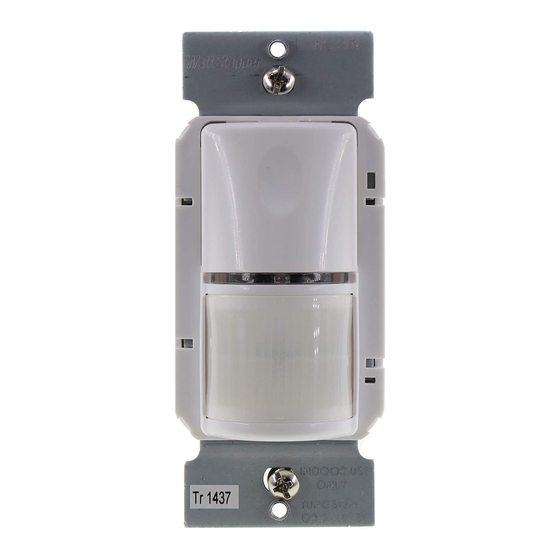Table of Contents
Advertisement
WS‑301/WS‑301‑347
SPECIFICATIONS
WS-301 Voltages ..............................................120 or 277VAC, 50/60Hz
Load Requirements
@ 120VAC.............0~1000W ballast, E‑ballast, LED, tungsten, 1/4 hp
@ 277VAC ........................0~1200W ballast, E‑ ballast & LED, 1/4 hp
WS-301-347 Voltage ...................................................347VAC, 50/60Hz
Load Requirements ..........................0~1500W ballast & LED, 1/4 hp
Common Features
Time Delay Adjustment ...............................30 seconds ‑ 30 minutes
Sensitivity Adjustment .......................................Minimum‑Maximum
Light Level Adjustment ........................................... 0‑200fc (@4000K)
Operating Temperature ................................................40 o C (104 o F)
Storage Temperature .....................................................70 o C (158 o F)
Terminal screw torque ......................................16 lbf‑in (18 kgf‑cm)
Optional Neutral Connection
Passive Infrared Wall Switch
Occupancy Sensor
WS-301-347
Advertisement
Table of Contents

Summary of Contents for wattstopper WS-301
-
Page 1: Specifications
WS‑301/WS‑301‑347 Passive Infrared Wall Switch Occupancy Sensor WS-301-347 SPECIFICATIONS WS-301 Voltages ..........120 or 277VAC, 50/60Hz Load Requirements @ 120VAC.....0~1000W ballast, E‑ballast, LED, tungsten, 1/4 hp @ 277VAC ......0~1200W ballast, E‑ ballast & LED, 1/4 hp WS-301-347 Voltage ...........347VAC, 50/60Hz Load Requirements ......0~1500W ballast & LED, 1/4 hp Common Features Time Delay Adjustment .......30 seconds ‑... -
Page 2: Unit Description And Operation
UNIT DESCRIPTION AND OPERATION The WS‑301 and WS‑301‑347 PIR Wall Switch Occupancy Sensors turn lighting or fan loads ON and OFF based on occupancy and ambient light level. They are designed to replace a standard light switch. The WS‑301 operates with 120 or 277VAC line voltage and the WS‑301‑347 operates with 347VAC line voltage. -
Page 3: Coverage Patterns
This allows you to eliminate coverage in unwanted areas. Since masking removes bands of coverage, remember to take this into account when troubleshooting coverage problems. Opaque tape Visit our website for FAQs: www.wattstopper.com... -
Page 4: Installation
INSTALLATION CAUTION Turn the power OFF at the circuit breaker before installing the sensor. 1. Connect the existing wires in the wall box to the sensor flying leads. (See Wiring Directions). • Do not allow bare wire to show below connector. • The ground wire must be tightly grounded for the unit to operate properly. -
Page 5: Wiring Directions
2. LINE to Black flying lead. 3. GROUND to Green . Neutral Load Black to Line Optional Green Neutral Single-level wiring Neutral Black Load to Line Load Optional Neutral Green Manual bi-level lighting wiring Visit our website for FAQs: www.wattstopper.com... -
Page 6: Sensor Adjustment
5. Reset the time delay to the desired setting. The time delay can be set from 30 seconds to 30 minutes in 5‑minute increments. Visit our website for FAQs: www.wattstopper.com... -
Page 7: Troubleshooting
Time Delay (T) Shown as set for 15 minutes 10 minutes 20 minutes 5 minutes 25 minutes 30 seconds 30 minutes (Walk-test) TROUBLESHOOTING Time Delay (T) Shown as set for 15 minutes Load will not turn ON: • LED does not flash: ‑ Check the sensitivity for proper Light Level (L) configuration. -
Page 8: Cover Plates
WattStopper warranties its products to be free of defects in materials and workmanship for a period of five (5) years. There are no obligations or liabilities on the part of WattStopper for consequential damages arising out of, or in connection with, the use or performance of this product or other indirect damages with respect to loss of property, revenue or profit, or cost of removal, installation or reinstallation.
















Need help?
Do you have a question about the WS-301 and is the answer not in the manual?
Questions and answers